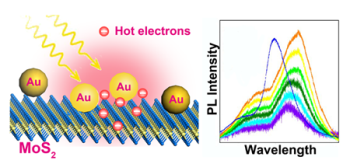Sep 15 2014
Plasmonic nanophotonics and two dimensional materials are hot topics for recent optics and condensed mater physics. How to combine surface plasmon and plat 2D materials, such as graphene and MoS2, and realize excitation light active control of material opto-electronic properties, is very important for the future application.

Professor Zhu Xing and Dr. Fang Zheyu from school of physics, working with the collaborators from Rice University, successfully realized the optical control of MoS2 monolayer photo luminescence (PL) by using plasmonic hot electron doping effect. This work was online published in top journal, as Advanced Materials, 2014, doi:10.1002/adma.201401802. The first author of this paper is Ms. Yimin Kang, the first year graduate student of Dr. Fang’s research group.
MoS2 monolayer, as a new two- dimensional nanomaterial, has aroused lots of attentions because of its novel physical phenomena on optical and electronic properties. The semiconducting (2H) to metallic (1T) structural phase transitions of MoS2 may be exploited as a means of optoelectronic control and catalysis regulation. However, because of the lack of controllability of size, defect, and edge effects, it is challenge to control this phase transition for single layers of MoS2.
Recently, Fang and his student succeeded to achieve a transient reversible 2H to 1T phase transition by using plasmonic hot electrons generated from surface plasmon absorption. This structure phase transition was recorded by Raman and PL spectroscopy in the ultra-high vacuum and low temperature chamber. These results provided new method for active control of MoS2 opto-electronic properties by using surface plasmon doping.
Fang's group has been working on the 2D material plasmonics for a couple of years (Invited Review: Adv. Mater. 25, 3840, 2013), such as plasmonic graphene-antenna photodetector (Nano Lett 12, 3808,2012), and graphene plasmonic electronic doping (ACS Nano 6, 10222, 2012); with the development of nanofabrication, graphene nanostructure with its localized surface plasmon was also detected (ACS Nano 7, 2388, 2013), and realized an enhanced mid-infrared absorption (Nano Lett 14,299,2014); furthermore, plasmonic heating effect was also used for catalysis(Nano Lett 13,1736,2013) and near-infrared photo detection(Nature Commun. 4,1643,2013).
This work was supported by 973 National Natural Science Foundation of China, Beijing National Science Foundation, state key laboratory for artificial microstructure and mesoscopic physics, and 2011 collaborative innovation center of quantum matter.
Edited by: Zhang Jiang